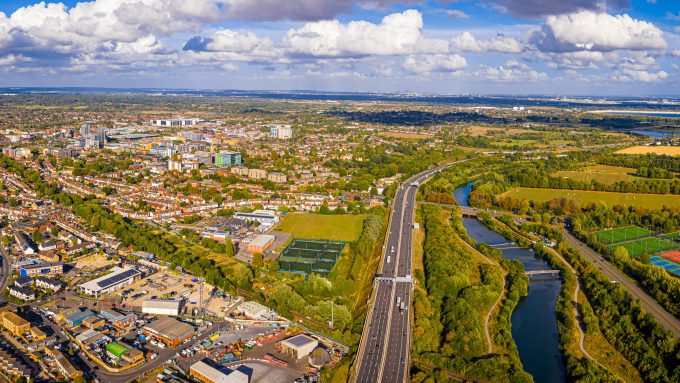
Port of Aberdeen aims high with net zero ambitions

Heavy downpours gave way to bright sunshine just as a small delegation arrived at a viewing platform overlooking Port of Aberdeen’s new South Harbour; one day prior to construction completing on 1.5km of additional deepwater quayside serving the city and region.
But this was no sneak peek of an otherwise deserted site just before operations began: beneath the group were several huge vessels already hard at work.
On the far side of the harbour was an offshore installation vessel carrying large components for a new turbine to be assembled at sea; closer to the group were two vessels: one being loaded with scrap materials ready for processing, and another laden with wood chips bound for Scandinavia.
Operations at Aberdeen South Harbour actually began just over a year ago, we were told, and the new facility can accommodate vessels up to 300m in length; a significant increase on the 165m limit in the North Harbour.
Final preparations are currently being made for the official opening of the new facility by HRH The Princess Royal on 22 September.

“This £420 million development gives extra capacity to the Port of Aberdeen, plus the ability to support a wider range of vessels than we ever could before,” explained the Port of Aberdeen’s Commercial Manager Marlene Mitchell. “We look after 7,000 vessels in the nearby North Harbour every year and Aberdeen is the largest logistics hub for the oil and gas sector in Europe.
“But this new expansion at South Harbour expands our scope to support a wider range of vessels.”
Port of Aberdeen – with an ambitious net zero target by 2040 – is earmarked as a testbed for demonstrating sustainable port technology and innovation, and the site has begun to make its mark in this regard.
Plans are being considered to understand how quayside operations at the new facility can be dominated by electric, rather than diesel power, and LED lighting has been installed throughout the port to aid with energy reductions. But this is just the start: the group was told that South Harbour aims to become a “living lab to lead the charge with innovation”.
It was also pointed out that novel civil engineering and technology was used in the construction of South Harbour. Its new 640m long breakwater jutting out to sea was built using thousands of ‘accropodes’ – large, star-shaped precast concrete components that lock together to provide a strong resistance to the waves.
Each accropode features an electronic locator chip so if the position of one was ever to be disturbed, the port’s maintenance managers will get to hear about it straight away.
Aberdeen is supporting the transition to green energy and is keen to realise the economic opportunities from increased interest in technologies such as offshore wind. “We don’t want work to go overseas,” Marlene added. “What benefits the port will benefit the city, the region and the whole country.”
Seminar sets out sustainable opportunities
The morning’s visit to site was followed by a seminar that afternoon hosted by Connected Places Catapult at the nearby Aberdeen Science Centre; during which a report was launched documenting the Aberdeen ‘Port Zero’ sustainability project.
The project – funded by the second round of the Department for Transport and Innovate UK’s Clean Maritime Demonstration Competition – aims to accelerate the transition to net zero in maritime, by reducing emissions through adapting and supporting innovative technology and processes.
“Ports play a crucial role in the decarbonisation of the maritime sector, and there are challenging targets to be met before 2050. But we are determined to reach net zero by 2040.”Port of Aberdeen’s Commercial Manager, Marlene Mitchell
She added that the port aims to eliminate not only its direct and indirect emissions, but also those of port users, which she added is “no small challenge”. “We welcome conversations – we are never going to be able to do so in isolation; we need to do it together.”
Marlene added that Aberdeen aims to become an “exemplar port” in terms of decarbonisation “and this project will help to support that ambition”.
Connected Places Catapult was represented at the seminar by several senior figures including Director of New Mobility Technologies, Professor Henry Tse. “Ports are perfect places to test novel, innovative technology” he explained.
Henry added that innovations in ports “will help to deliver faster impact and accelerate necessary transitions in the transport sector as a whole, leading to wider positive impacts for the supply chain and increasing the efficiency of goods through UK borders”.
The role of ports in demonstrating a decarbonised future is crucial, he added.

“Ports are intense ecosystems where different modes of transport intersect, and they play a crucial part in society. They will become central to delivering on decarbonisation.”
Also addressing the event were Aberdeen City Council’s Chief Officer for Strategic Place Planning, David Dunne; British Ports Association’s Director of Policy and External Affairs Mark Simmonds; Energy Systems Catapult’s Consultant Engineer Grant Tuff; Buro Happold’s Senior Energy Engineer Luigi Piani; Port of Aberdeen Chief Executive Bob Sanguinetti and Connected Places Catapult’s System Engineer Paul Wilson. A panel session was moderated by Connected Places Catapult's Team Leader for Maritime in New Mobility Technologies, Richard Holland.





